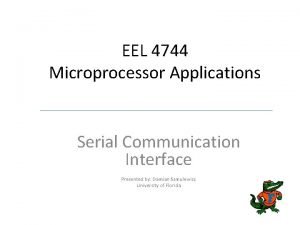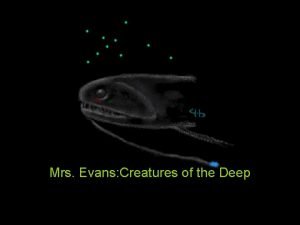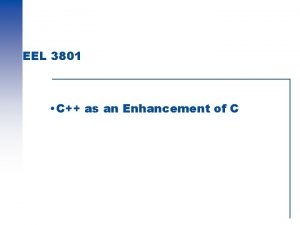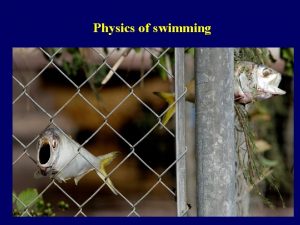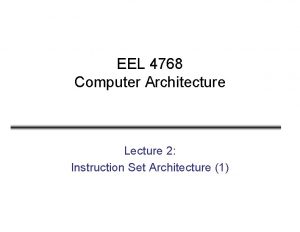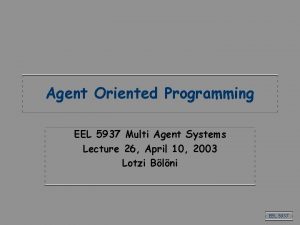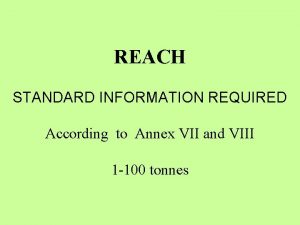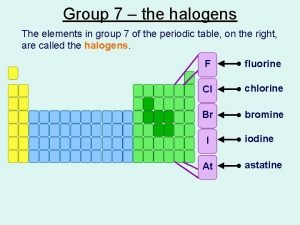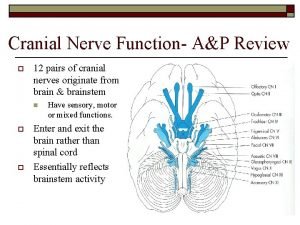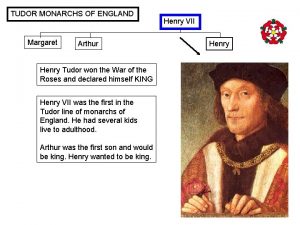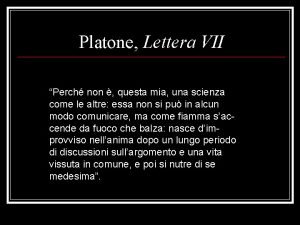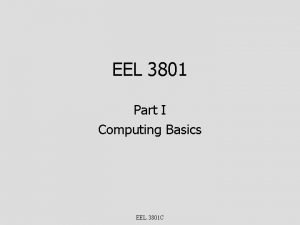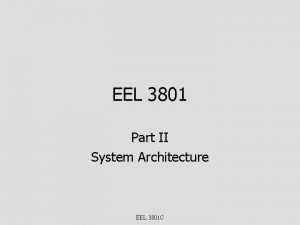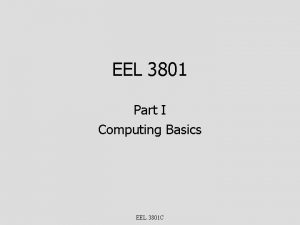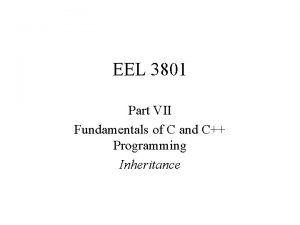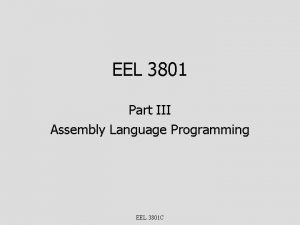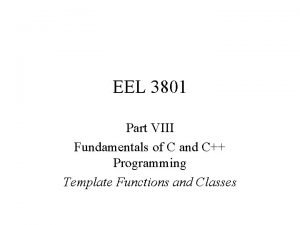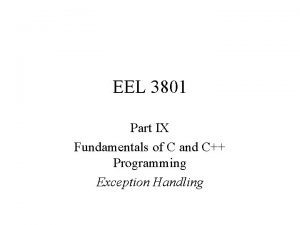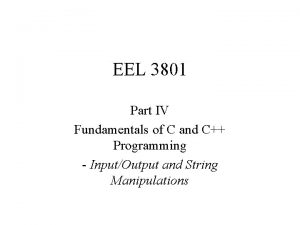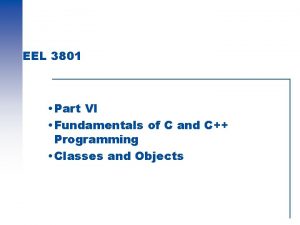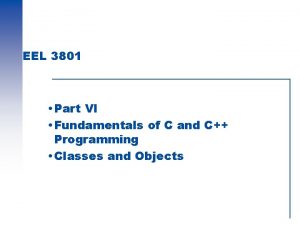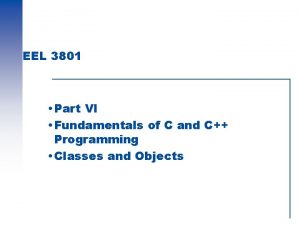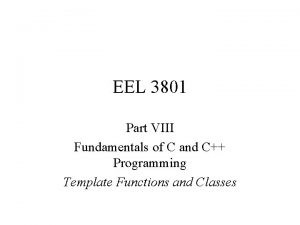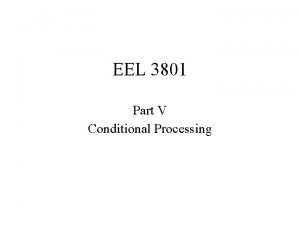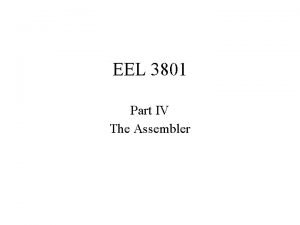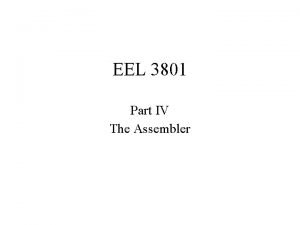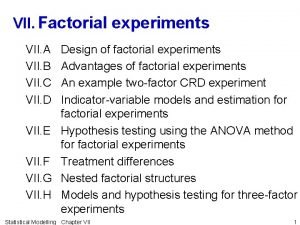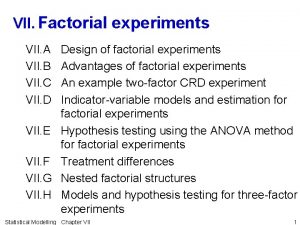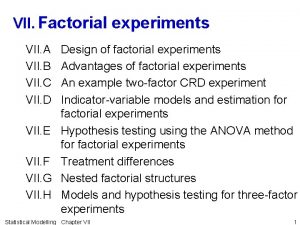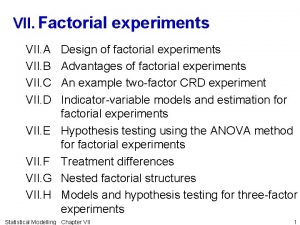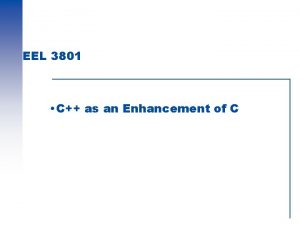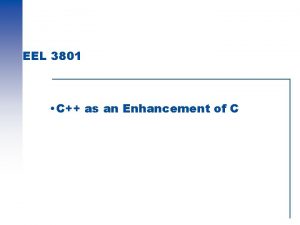EEL 3801 Part VII Fundamentals of C and











































- Slides: 43

EEL 3801 Part VII Fundamentals of C and C++ Programming Inheritance

Inheritance • A form of software reusability in which new classes are derived from existing classes. – Derived classes acquire their parent’s attributes. – They can enhance these attributes. – This encourages software re-use. • Avoids having to repeat general code for several related classes.

Inheritance - Terminology • Base class is the name for the parent from which all is being inherited. Is also called the superclass. • Derived class is the name for the class that does the inheriting. Is also referred to as the subclass. • Inheritance implements an is-a relationship: • For example - a mustang is-a car.

Hierarchical Inheritance • Inheritance is hierarchical: – A derived class can also act as a base class to a lower-level derived class. – The higher the class in the hierarchy, the more general information it contains. – The lower the class in the hierarchy, the more specific information it contains. • Attributes in a derived class overwrite the same ones in a base class.

Hierarchical Inheritance Automobile is-a Sedan is-a Taurus is-a Convertible is-a Mustang is-a SUV is-a Explorer

Inheritance • Defined syntactically in C++ as follows: class Engineer : Employee. . . }; { • This is referred to as default inheritance. • Can be changed, as we shall see later.

Default Inheritance • A derived class contains all the information in the public: parts of the base class. • A public: member function of the base class is automatically a member function of the derived class. • Therefore, no reference to the base class is needed when calling a (public: ) base class function from the derived class

Inheritance • The derived class does not have access to the private: members of the base class. • It must access private: members in the same way as external client functions through public: access functions. • This can be a significant constraint in the operation of derived class. • So the protected: members exist.

The protected: Members • A new type of access is now defined protected: – Acts as a private: member to outside client functions. – Acts a public: member to derived classes. • All that applies to public: members also applies to protected: members from the point of view of the derived class.

The protected: Members • Member functions of derived classes can directly refer to public: and protected: members of their base classes. • This means that they do not need to use the scope resolution operator to do so. • Here is an example of inheritance and its use.

Example #1 - Base Class #include <stream. h> #include <string. h> class Student { public: void display(); void create_rec(char *, int); private: char * name; int year; };

Example #1 - Member Functions void Student: : display() { cout << form(“n name: . . “, name, year); }; void Student: : create_rec(char * n, int y) { name = new char[strlen(n) + 1]; strcpy(name, n); year = y; }

Example #1 - Derived Class // Derived class definition class On_campus : Student { public: void a_disp(); void new_student(char*, int, char*, char *); private: char *dorm; char *room; };

Example #1 - DC Functions void On_campus: : a_disp() { display(); // shows base class value cout << form(“Dorm. . ”, dorm, room); }

Example #1 - DC Functions Void On_campus: : new_student(char * n, int y, char * d, char * r) { create_rec(n, y); dorm = new char{strlen(d) + 1]; strcpy(dorm, d); room = new char[strlen(r) + 1]; strcpy(room, r); }

Example #1 - main() Function main() { Student x; x. create_rec(“Joe Smith”, 1); x. display(); On_campus y; y. new_student(Billy Bob”, 1, “Seminole Hall”, “L 301”); y. a_disp(); }

Example #2 - nd 2 Derived Class class Off_campus : Student { public: void a_disp(); void new_student(char *, int, char *, char *); private: char *street; char *city; char *state; char *zip; };

Example #2 - Functions void Off_campus: : a_disp() { display(); //prints out basic values cout << form(“address …”, street, city, state, zip); }

Example #2 - Functions void Off_campus: : new_student(char *n, int y, char *s, char *cty, char *st, char *z) { create_rec(n, y); street = new char[strlen(s) + 1]; strcpy(street, s); city = new char[strlen(s) + 1]; strcpy(city, cty); state = new char[strlen(s) + 1]; strcpy(state, st); zip = new char[strlen(s) + 1]; strcpy(zip, z); }

Example #2 - main() Function main() {. // Up to this point same as before. Off_campus z; z. new_student(“Sally Green”, 2, “ 123 Main Street”, “Oviedo”, “FL”, “ 32816”); z. a_disp(); }

Example #2 • Note that the member functions of the two derived classes have the same name. This is OK, as they are mutually-exclusive. • Both a_disp() functions are able to use the base class’s display() function, as it has public: access. • But their names are NOT the same as that of the base class. This would be ambiguous!

Example #3 • But what if we decided to re-label the function a_disp() within the derived classes as display()? (change name) • We would need to disambiguate between display() functions in the base class and those in the derived classes. • We can do that with the : : scope resolution operator as follows:

Example #3 • The base class Student and its member functions display() and create_rec() would remain unchanged from those of Example #1. • The On_campus and Off_campus derived classes would also be the same as in Example #2, except a_disp() would now be renamed display().

Example #3 • The biggest difference is how we disambiguate from the two display() functions: one in the base class, and one in the derived class: void On_campus: : display() { Student: : display(); cout << …; }

Over-written Functions • The same thing goes for the display() function in the Off_campus derived class. • These functions are NOT overloaded, since they have exactly the same prototype (and header), and they are not in the same class. • They are over-written functions. • The over-written function that is closest to the object defined takes precedence.

Example #4 • If we use the class hierarchy defined in Example #3, and write the following main() function: main() { Student x; Off_campus y; x. display(); //display in base class y. display(); //display in der. class y. Student: : display() // base class }

Constructors and Destructors • Constructors and Destructors are also inherited since they are typically public. • However, there must be some coordination between those of the base and those of the derived classes: – which one executes first – how does the base constructor receive values from the derived constructor, if necessary.

Coordination • If constructors and destructors are defined both for the base and the derived classes, – the base constructor is always called first. – the derived constructor is always called only after the base class constructor finishes. – The derived destructor is always called first. – the base destructor is always called only after the derived class destructor finishes.

Value Exchange • This is a little more difficult to describe. • When a variable object of a derived class is being instantiated, an object of the base class must also implicitly be instantiated. • That base class “object” (it does not really exist explicitly) must also have run its constructor. • It needs values for that constructor to run.

Value Exchange • The required values must be appended to the definition of the derived class object’s constructor when the object is instantiated. • The syntax is simple: Der_class(int x, int y, int z) : (x, y); • Where (x, y) are the values needed by the base class constructor. z is only required by the derived class constructor.

Value Exchange • For destructors, it is significantly easier, as they accept no arguments. • C++ takes care of any coordination and value exchanges to be done, if any, for the destructors.

Example #5 • This example shows the student class hierarchy with the constructors and destructors added. • Only the differences will be shown for efficiency of space and lower confusion. • Note that the create_rec()function is replaced by the constructor as the means of creating a record for a student.

Example #5 - Base Class class Student { public: Student(char *, int); ~Student() { delete name; } void display(); // void create_rec(char *, int); is // no longer needed private: char * name; int year; };

Example #5 - Base Class Constr. Student: : Student(char * n, int y) { name = new char[strlen(n) + 1]; strcpy(name, n); year = y; }

Example #5 - Derived Class class On_campus : Student { public: On_campus(char*, int, char*); ~On_campus() { delete dorm; delete room; } void display(); // void new_student() this function is // no longer used private: char * dorm; char * room; };

Example #5 - DC Constructor On_campus: : On_campus(char * n, int y, char * d, char * r) : (n, y) { dorm = new char[strlen(d) + 1]; strcpy(dorm, d); room = new char[strlen(r) + 1]; strcpy(room, r); }

Example #5 - main() Function main() { Student x(“Joe Smith”, 1); x. display(); On_campus y(“Alex Gonzalez”, 1, “Seminole Hall”, “D 301”); y. display(); // local display() }

Types of Inheritance • The default inheritance discussed before is also referred to as private inheritance: – Public members of the base class are inherited as private in the derived class. – Protected members of the base class are inherited as private in the derived class. – Private members of the base class are not inherited at all.

Example #6 - Private Inheritance class Base { public: Base(int); int display(); private: int x; }; class Derived : Base{ public: Derived(int, int); do_it(); private: int y; };

Example #6 - Private Inheritance class Sub_derived : Derived public: Sub_derived(int, int); do_it(); private: int y; }; {

Example #6 - Private Inheritance main() { Base a(10); Derived b(5, 20); Sub_derived c; a. display(); // permissible because // it is public in Base c. display(); // results in error // because it is // derived as private. }

Types of Inheritance • To rectify the problem, C++ also has two other types of inheritance: – public: • Public members in Base become public Members in Derived • Protected members in Base become protected members in Derived – protected: • Public and protected members in Base become protected members in Derived.

Public Inheritance • Can be accomplished by adding the word public after the colon in the derived class header. class Derived : public Base { public: Derived(int, int); do_it(); private: int y; };
 Pieier
Pieier Iram 3801
Iram 3801 Anemone producers consumers and decomposers
Anemone producers consumers and decomposers Keckwick woman in black
Keckwick woman in black Pelican eel habitat
Pelican eel habitat Deep-sea shrimp
Deep-sea shrimp Eel gird
Eel gird Rahvusvahelised suhted
Rahvusvahelised suhted Eel 3705
Eel 3705 Usp
Usp Deep sea hatchetfish adaptations
Deep sea hatchetfish adaptations C++ eel
C++ eel Garbage milkshake analogy
Garbage milkshake analogy Metaphors for challenges
Metaphors for challenges Physics in swimming
Physics in swimming Eel 4768
Eel 4768 Eel 4768
Eel 4768 What does i feel like a limp dishcloth mean
What does i feel like a limp dishcloth mean Sentence variety
Sentence variety Escola de eel
Escola de eel Eel 4712
Eel 4712 Eel programming language
Eel programming language Resolution no. 435 series of 1997
Resolution no. 435 series of 1997 Hexacarbon decahydride formula
Hexacarbon decahydride formula Fernando vii
Fernando vii Reach annex vii
Reach annex vii De ce numi vii
De ce numi vii Pedagogika qanday fan
Pedagogika qanday fan What are halogens
What are halogens Pasari carenate
Pasari carenate Cn 2 test
Cn 2 test Cranial nerve assessment
Cranial nerve assessment Henryk vii tudor
Henryk vii tudor Inmultirea la animale
Inmultirea la animale Monarchs of england
Monarchs of england King henry vii family tree
King henry vii family tree 100 people surveyed
100 people surveyed Lettera vii platone
Lettera vii platone Nerf vii bis
Nerf vii bis What is the theme of the poem song vii
What is the theme of the poem song vii 6/1996. (vii. 16.) müm rendelet
6/1996. (vii. 16.) müm rendelet 10/2015 (vii. 30) hm
10/2015 (vii. 30) hm Fernando vii absolutismo
Fernando vii absolutismo Vii=i solucion
Vii=i solucion
